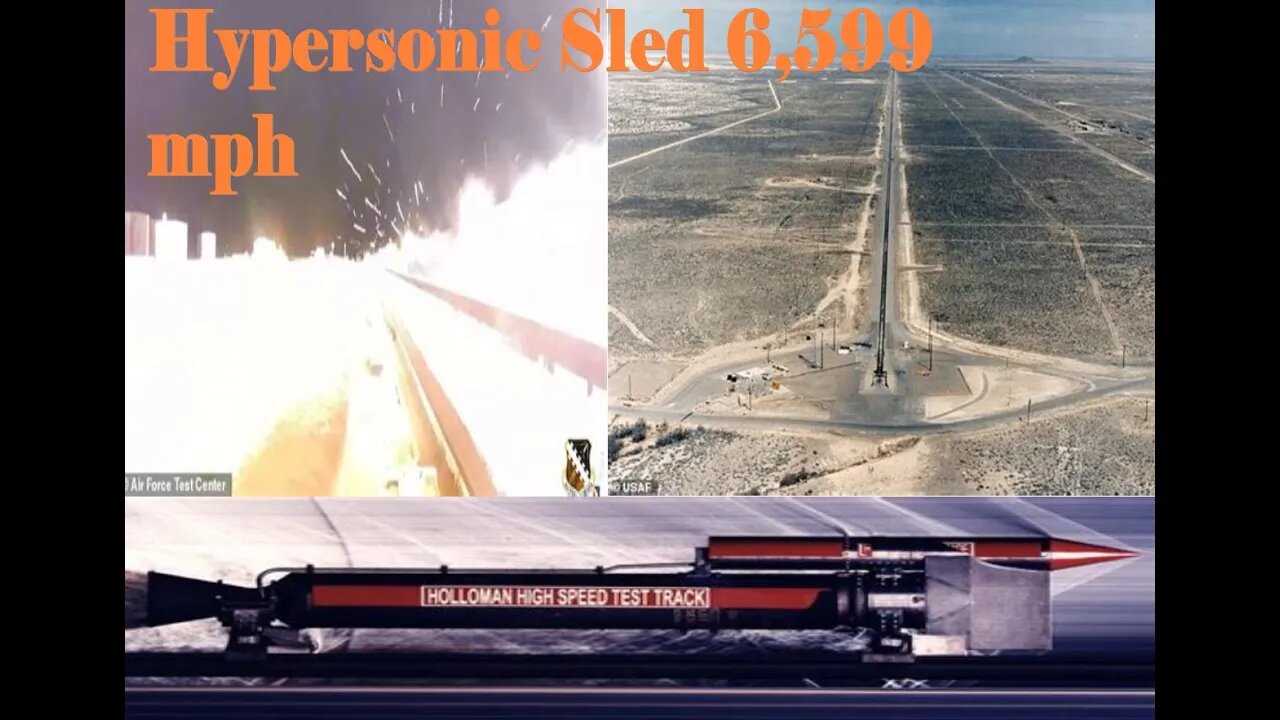Premium Only Content

Hypersonic sled travels at 6,599 mph Mach 8.6 at Holloman Air Force Base
The Holloman AFB is also home to the Holloman High-Speed Test Track (HHSTT) which was first built in 1949 to provide a realistic and cost-effective testing environment for weapons, systems, and components. The facility that serves all the units of the U.S. military also helps procurement agencies and defense contractors evaluate the technologies and components under development.
The Holloman High-Speed Test Track
The HHSTT was only 3,350 feet (1.021 m) long when built. Over the years, the track was lengthened and is currently 50,971 feet (15,536 m) long. That's a little short of the 10-mile mark.
The tracks are used to launch rocket-powered test vehicles, also called sleds. More than 12,000 such sled tests have been conducted at the facility in more than five decades, and the facility has been operational. Apart from speed tests and aerodynamic tests, the facility has also been a test bed for other technologies such as rain and erosion tests and weapons dispensation tests.
In addition to being the world's longest track, it also bagged the title of being the world's fastest in 2003, when a test sled clocked the hypersonic speed of Mach 8.6. This is traveling at a speed of 9,465 feet (2.8 km) per second.
The track serves as a critical link between laboratory-type investigations and full-scale flight tests. Researchers can simulate selected portions of the flight environment under carefully controlled conditions at the HHSTT.
MOST POPULAR
Recovering hypersonic sleds
Hypersonic tests can reveal a lot about a weapon's flight performance, and survivability before more expensive flight tests begin. Also, once a weapon enters flight trials, the chances of recovering components to study flight impact reduce considerably. This is why the HHSTT has concentrated its efforts On Hypersonic Sled Recovery (HSR) as well. Recovered sleds can be used to collect critical post-test data, especially in new weapon systems such as hypersonic missiles.
The 846 Test Squadron at HHSTT has been working to improve high-speed braking at the facility. In March, the testing team managed to successfully stop a reusable sled that was traveling at 6,400 feet (1,950 m) per second.
"What you accomplished marked the fastest recovery of a monorail sled in over 30 years, and the first time we have recovered a planned reusable sled at those speeds ever," Lt. Col. Paul Dolce, Commander, 846th Test Squadron told the team members after the testing, the press release said. "These efforts will now set up our future HyTIP [Hypersonic Test and Evaluation Investment Portfolio] runs for success and add a new capability for our hypersonic customers."
message circleSHOW COMMENT (0)chevron
FOR YOU
SCIENCEie-premium
Scientists discover a 100-year-old math error, changing how humans see color
Scientists correct a key math error in the work of Edwin Schrödinger and others on color perception, potentially improving image and video processing.
Paul Ratner | 11/09/2022
The first firm to get an Apollo 11 contract is helping build NASA's Artemis software
INNOVATIONpremium
The first firm to get an Apollo 11 contract is helping build NASA's Artemis software
Chris Young| 02/08/2022
Lego-like recycling will transform how we use these future plastics
SCIENCEpremium
Lego-like recycling will transform how we use these future plastics
Sade Agard| 06/10/2022
MORE STORIES
INNOVATION
Military drones may be high-tech but this stick-built one sticks out
Loukia Papadopoulos| 06/11/2022
SCIENCE
premium
This company launches the ashes of your loved ones into space
Sade Agard| 10/09/2022
CULTURE
Humanoid robots could generate $154 billion in revenue over next 15 years, Goldman Sachs reports
Loukia Papadopoulos| 05/11/2022
-
 LIVE
LIVE
Right Side Broadcasting Network
6 hours ago🎅 LIVE: Tracking Santa on Christmas Eve 2024 NORAD Santa Tracker 🎅
1,840 watching -
 2:48
2:48
Steven Crowder
9 hours agoCROWDER CLASSICS: What’s This? | Nightmare Before Kwanzaa (Nightmare Before Christmas Parody)
167K12 -
 LIVE
LIVE
LFA TV
10 hours agoLFA TV CHRISTMAS EVE REPLAY
724 watching -
![ROSEANNE BARR - Her Journey, TRUMP, and the MAGA GOLDEN AGE! [INTERVIEW]](https://1a-1791.com/video/s8/1/M/m/B/2/MmB2v.0kob.1-small-ROSEANNE-BARR-Her-Journey-T.jpg) 51:35
51:35
Dr Steve Turley
1 day ago $10.53 earnedROSEANNE BARR - Her Journey, TRUMP, and the MAGA GOLDEN AGE! [INTERVIEW]
24.9K37 -
 57:38
57:38
The Tom Renz Show
3 hours agoMerry Christmas - The Tom Renz Show Christmas
32.3K8 -
 2:59:10
2:59:10
Wendy Bell Radio
14 hours agoThe Bridge Too Far
127K190 -
 1:03:45
1:03:45
Donald Trump Jr.
1 day agoHappy Festivus: Airing Our Grievances and Stopping The Swamp w/Sean Davis | TRIGGERED Ep.201
398K524 -
 1:30:30
1:30:30
Game On!
17 hours ago $7.31 earnedTop 5 things you need to know for Sports Christmas!
54.6K4 -
 1:58:10
1:58:10
Robert Gouveia
1 day agoMatt Gaetz REJECTS Report, Sues Committee; Luigi Fan Club Arrives; Biden Commutes; Festivus Waste
280K224 -
 1:31:40
1:31:40
Adam Does Movies
1 day ago $15.47 earnedThe Best & Worst Christmas Movies! - LIVE!
106K8